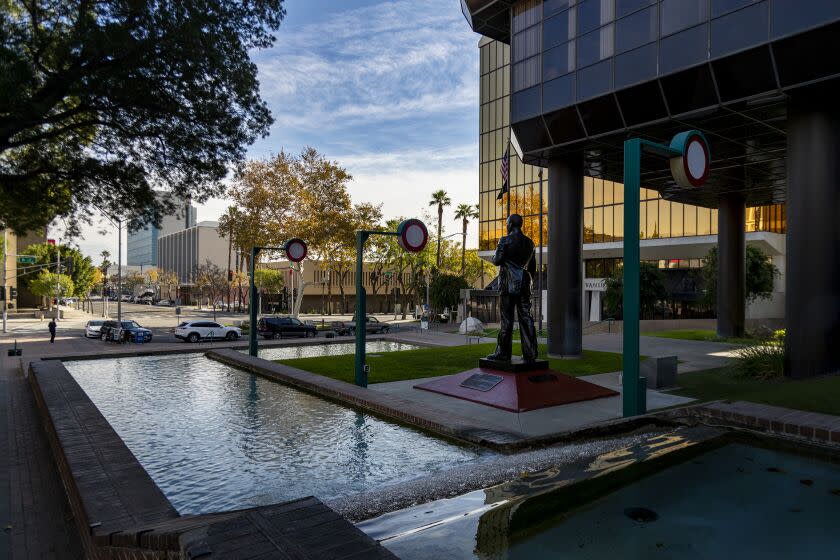'California needs to do a better job': San Bernardino County will study seceding after voters' OK

There have been at least 220 attempts to break up California since the state was formed in 1850. None has succeeded.
Still, a slight majority of San Bernardino County voters say the idea is worth exploring.
A November ballot measure directing county officials to review how to secure more resources and funding — "up to and including secession from the State of California" — passed with 50.6% of the vote. County election officials certified the results Dec. 8.
Although voters approved the measure, the likelihood of a new state forming east of Los Angeles — the first since Hawaii was granted statehood in 1959 — is an extreme long shot. The San Bernardino County Board of Supervisors will study how the county can receive "its fair share of state and federal resources," Supervisor Curt Hagman said in a statement. And if officials decide they want to form their own state, Congress and the California Legislature would need to sign off.
Rancho Cucamonga developer Jeff Burum first lobbed the idea of a secession movement at county officials in the summer. He maintains the idea was born out of frustration with unfair distribution of resources from state lawmakers.
"I think the state of California needs to do a better job of allocating dollars our way," Burum said. "I think the whole idea is to study the shortfall, and then plan for the future and what we can and can't do about it."
State Sen. Connie Leyva (D-Chino), Assembly Majority Leader Eloise Gómez Reyes (D-Grand Terrace) and Assemblymember Freddie Rodriguez (D-Pomona) said they were disappointed that San Bernardino County was weighing its options to flee California.
“Your action today to put this question, with unclear outcomes, on the ballot for San Bernardino County voters begs the question of why are we spending public resources to put this before voters in the first place?” they wrote in August.
Secession is not the ultimate goal of the initiative, Burum said. But with nearly 2.2 million residents in 20,105 square miles — the largest county by area in the contiguous U.S. — Burum said he can't imagine a future for a county the size of San Bernardino if its state funding levels don't change.
A county assessment released before the November election showed San Bernardino receives $1,071 in state and federal funding per resident, ranking 36th among California's 58 counties — above Orange, Alameda, San Diego, Riverside and Contra Costa counties, and below Los Angeles, Napa, Sacramento and Monterey counties.
Though historically the county has skewed conservative, in recent years registered Republicans have lost ground as the Inland Empire saw a steady rise in new residents, and as of 2013, San Bernardino is predominantly Latino, according to census data. Roughly 41% of registered voters are Democrats and 29% are Republicans, according to the San Bernardino County registrar of voters.
But in November's general election, most Democratic candidates vying for state office finished behind Republican challengers in San Bernardino County. Though Gov. Gavin Newsom coasted to reelection, he lost San Bernardino County to Republican Brian Dahle, 53% to 47%.
Burum said he does not see the initiative to explore secession as a partisan issue but faults Democratic leadership with failing San Bernardino and the rest of the Inland Empire.
As other parts of the state lost residents from 2020 to 2021, San Bernardino, Riverside, Kern and San Joaquin counties saw population gains. Burum said that growth should warrant more attention from state lawmakers and an increase in funding.
The push for secession is nothing new in California.
In rural Northern California, several counties have vied to break away from the Golden State to form what they call the state of Jefferson.
In a local secession effort, the San Fernando Valley tried to break away from the city of Los Angeles 20 years ago, but that failed to gain enough support from voters.
Other initiatives raised the same complaints as Burum and some San Bernardino residents in 2022: lack of representation, funding and resources.
But a breakaway San Bernardino does not make sense to Sherry Bebitch Jeffe, co-host of the "Inside Golden State Politics" podcast.
"It is not rational that a county in the middle of a huge state decides it wants to be its own state," Jeffe said. "There's just so much that has to be done in order to put together a government. It's extremely expensive."
Burum said he expects to be part of the committee that will determine whether San Bernardino can secure more funding or put its efforts toward secession.
"We just don't want the rest of California to think of us as an afterthought," Burum said. "Or for people to move out here just because, you know, it's a distribution center where they get a job nearby. We want people to come here and stay here and raise their families here because they're proud of our area."
This story originally appeared in Los Angeles Times.

